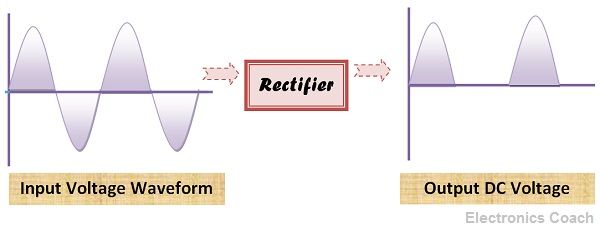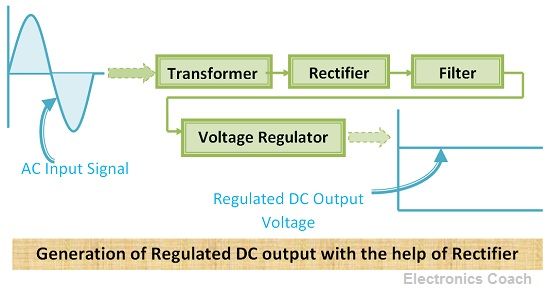A rectifier is a device which converts sinusoidal AC (alternating current) voltage into pulsating DC (Direct Current) voltage. The single phase rectifiers are classified basically into two types that are half wave rectifier and full wave rectifier. Half wave rectifiers are those which convert one-half cycle of AC voltage into DC voltage, while full wave rectifiers are those which utilize positive half cycle as well as the negative half cycle for generation of pulsating DC voltage.
Circuit Components of Rectifiers
In our previous article, we have discussed diodes and their types. A question emerges in this context that why diode is considered as the backbone of various electronic devices and circuits? What is the significance of diode?
The answers to these question will be clear in this article of rectifiers. So far we have discussed working of diode but now we will see its practical utility. Rectifier’s main component is diode. The conversion process of AC signal into DC signal is performed by rectifier with the help of diode only.
The ability of the diode to conduct in forward biased and to act as an open circuit on reversed biased makes it appropriate for switching between the positive half cycle of the signal and negative half cycle of the signal. Thus, the diode is a crucial component of the rectifier. Rectifiers may contain one, two, three or four diodes according to the requirement for a particular purpose.
Significance of Rectifier
We have already discussed above that rectifier is a device which converts AC voltage into pulsating DC voltage. But you may think that why to convert into DC? Is there any need to convert the AC voltage into DC, why we cannot use AC voltage for every application?
Let me answer your question. It is economical to supply AC power through high voltage transmission lines, but for certain application, we need DC supply. Electronics devices deal with low voltage or DC voltage, thus, DC voltage is crucial for operating electronic devices and circuits.
Although Dry cells and batteries can be used for DC power and they are portable and ripple free also, but still, they cannot be used for major applications because they need to be replaced frequently and are costly if we will compare it to conventional DC supply.
A conventional DC supply is obtained by using rectifier and filter and it is passed through a voltage regulator to generate regulated DC voltage.
Working of Rectifier
A rectifier consists of transformer following a diode and a resistor. The transformer used is a step-down transformer. This is because the AC voltage is very high in magnitude. The transmission of AC signal at high voltage is economical, thus, AC voltage is supplied at high voltage. With the help of step down transformer, this high voltage is converted into low voltage AC.

After conversion of high voltage AC to low voltage AC, the low voltage AC signal is passed through the diode. The diode conducts during forward biasing. When the positive half cycle of AC signal is passed through the diode, the diode starts operating and starts conducting.
When negative half of input cycle is passed through the diode, the diode operates in reversed biased and becomes an open circuit. Thus, no output voltage is produced during the negative half cycle of the input. The input AC signal generates a positive output signal or signals in one direction only. Thus, the output voltage so produced is DC voltage.
The output voltage generated by rectifier is not purely DC it consists of some AC ripples also thus it is called pulsating DC signal.
Application of Rectifier in DC power Supply
DC power supply is used in various electronic circuits. It is commonly used because it is not so expensive and does not need frequent replacement. A rectifier is used in DC power supply along with transformer, rectifier, filter and voltage regulator.

We have discussed in the working of rectifier that it generates pulsating DC supply. It means unwanted AC components are also present along with DC voltage. The frequency of ripples is same as the frequency of input signal or harmonics of this input frequency.
These ripples are unwanted for smooth operation. Thus, in order to generate regulated DC supply, a filter circuit is used, it consists of reactive circuit elements such as capacitors, inductors and resistors. The filters are tuned to certain frequencies thus, they filter the signal of tuned frequency.
Voltage Regulator
The filtered output is then passed through a voltage regulator, the voltage regulator is needed to provide a constant output voltage. The output voltage generated by rectifier is not constant because it varies due to variation in load current or due to variation in input voltage. Thus, a constant voltage can be obtained if the voltage regulator is used. It can be constructed by using a Zener diode.
The voltage regulator also removes AC components from the signal in case of AC component is not filtered by filter present in the circuitry. Besides, it also acts as a current limiting element or prevents the circuit from the thermal shutdown.
Martiens J Bekker says
Thanks, well explained!